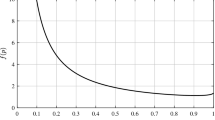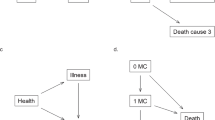Abstract
This paper reconsiders several results of historical and current importance to nonparametric estimation of the survival distribution for failure in the presence of right-censored observation times, demonstrating in particular how Volterra integral equations help inter-connect the resulting estimators. The paper begins by considering Efron’s self-consistency equation, introduced in a seminal 1967 Berkeley symposium paper. Novel insights provided in the current work include the observations that (i) the self-consistency equation leads directly to an anticipating Volterra integral equation whose solution is given by a product-limit estimator for the censoring survival function; (ii) a definition used in this argument immediately establishes the familiar product-limit estimator for the failure survival function; (iii) the usual Volterra integral equation for the product-limit estimator of the failure survival function leads to an immediate and simple proof that it can be represented as an inverse probability of censoring weighted estimator; (iv) a simple identity characterizes the relationship between natural inverse probability of censoring weighted estimators for the survival and distribution functions of failure; (v) the resulting inverse probability of censoring weighted estimators, attributed to a highly influential 1992 paper of Robins and Rotnitzky, were implicitly introduced in Efron’s 1967 paper in its development of the redistribution-to-the-right algorithm. All results developed herein allow for ties between failure and/or censored observations.
Similar content being viewed by others
References
Andersen PK, Borgan O, Gill RD, Keiding N (1993) Statistical models based on counting processes. Springer, New York
Baer BR, Strawderman RL, Ertefaie A (2023) Causal inference for the expected number of recurrent events in the presence of a terminal event. arXiv preprint arXiv:2306.16571
Carter M, van Brunt B (2012) The Lebesgue–Stieltjes integral: a practical introduction. Springer, New York
Efron B (1967) The two sample problem with censored data. In: Le Cam LM, Neyman J (eds) Proceedings of the fifth Berkeley symposium on mathematical statistics and probability. University of California Press, Berkeley, pp 831–853
Gill RD (1980) Censoring and stochastic integrals. Mathematisch Centrum, Amsterdam
Gill RD, Johansen S (1990) A survey of product-integration with a view toward application in survival analysis. Ann Stat 18(4):1501–1555
Gomez G, Julià O, Utzet F, Moeschberger ML (1992) Survival analysis for left censored data. In: Klein JP, Goel PK (eds) Survival analysis: state of the art. Springer, Dordrecht, pp 269–288
Groeneboom P, Wellner JA (1992) Information bounds and nonparametric maximum likelihood estimation. Birkhäuser, Basel
Gu MG, Zhang C-H (1993) Asymptotic properties of self-consistent estimators based on doubly censored data. Ann Stat 21(2):611–624
He S, Yang GL (1998) Estimation of the truncation probability in the random truncation model. Ann Stat 26:1011–1027
Helton JC (1977) Two generalizations of the Gronwall inequality by product integration. Rocky Mt J Math 7(4):733–749
Helton JC (1978) Solution of two Volterra integral equations. Rocky Mt J Math 8(3):547–554
Huang J, Wellner JA (1996) Regression models with interval censoring. In: Imbragimov IA, Zaitsev A (eds) Probability theory and mathematical statistics. Gordon and Breach, Amsterdam, pp 269–296
Kaplan EL, Meier P (1958) Nonparametric estimation from incomplete observations. J Am Stat Assoc 53(282):457–481
Malani H (1995) A modification of the redistribution to the right algorithm using disease markers. Biometrika 82(3):515–526
Mangalam V, Nair GM, Zhao Y (2008) On computation of NPMLE for middle-censored data. Stat Prob Lett 78(12):1452–1458
Mykland PA, Ren J-J (1996) Algorithms for computing self-consistent and maximum likelihood estimators with doubly censored data. Ann Stat 24(4):1740–1764
Robins JM, Rotnitzky A (1992) Recovery of information and adjustment for dependent censoring using surrogate markers. In: Jewell N, Dietz K, Farewell V (eds) AIDS epidemiology-methodological issues. Birkhäuser, Boston, pp 297–331
Rogers CA (1980) A less strange version of Milnor’s proof of Brouwer’s fixed-point theorem. Am Math Mon 87(7):525–527
Satten GA, Datta S (2001) The Kaplan–Meier estimator as an inverse-probability-of-censoring weighted average. Am Stat 55(3):207–210
Shen P-S (2003) The product-limit estimate as an inverse-probability-weighted average. Commun Stat Theory Methods 32(6):1119–1133
Shen P-S (2005) Estimation of the truncation probability with left-truncated and right-censored data. Nonparametr Stat 17(8):957–969
Shen P-S (2014) Nonparametric estimation with left-truncated and right-censored data when the sample size before truncation is known. Statistics 48(2):315–326
Strawderman, R. L. (2023). On the solutions to Efron’s self-consistency equation. arXiv:2301.09020
Tsai W-Y, Crowley J (1985) A large sample study of generalized maximum likelihood estimators from incomplete data via self-consistency. Ann Stat 13(4):1317–1334
Turnbull BW (1974) Nonparametric estimation of a survivorship function with doubly censored data. J Am Stat Assoc 69(345):169–173
Turnbull BW (1976) The empirical distribution function with arbitrarily grouped, censored and truncated data. J R Stat Soc Ser B (Methodol) 38(3):290–295
Zhang X, Zhang M-J, Fine JP (2009) A mass redistribution algorithm for right-censored and left-truncated time to event data. J Stat Plan Inference 139(9):3329–3339
Acknowledgements
This revision of an earlier work due to Strawderman (2023) was initiated during BRB’s postdoctoral study at the University of Rochester. RLS and BRB contributed equally to its final content. RLS and BRB thank David Oakes for a helpful conversation that led to the supplemental proof of Proposition 3; BRB also thanks David Oakes for an introduction to the redistribute-to-the-right algorithm.
Author information
Authors and Affiliations
Corresponding author
Additional information
Publisher's Note
Springer Nature remains neutral with regard to jurisdictional claims in published maps and institutional affiliations.
Supplementary Information
Below is the link to the electronic supplementary material.
Appendix
Appendix
1.1 Proof of Proposition 1
Proof
To prove (8), we begin by noting that \(t < X_{(m)}\) guarantees that \(Y(u+) > 0\) for \(u \le t\). Hence, using results briefly summarized in Gill and Johansen (1990, p. 1526) for general forms of anticipating Volterra integral equations, the unique solution to (7) is given by

Here, the finite product form given in the last equality on the right-hand side arises because \(C(\cdot )\) can only jump at a finite set of times. To see that (22) reduces to (8), observe that straightforward algebra yields
Now, we can write \(Y(u)-Y(u+) = \Delta N(u) + \Delta C(u);\) hence, \(Y(u+) + \Delta C(u) = Y(u) - \Delta N(u) = Y^{\dagger }(u)\) and it follows immediately that

establishing (8).
To see that result (9) follows under the assumption that \(\Delta N(u) \Delta C(u) = 0\) for \(u< X_{(m)}\), we simply note
which is equivalent to (9). This latter form is also the known unique solution to the integral equation for \({\widehat{K}}(t)\) stated in the theorem for the case where \(\Delta N(u) \Delta C(u) = 0\) for \(u< X_{(m)};\) see, for example, Theorem II.6.1 in Andersen et al. (1993, Sec. II.6). \(\square \)
1.2 Proof of Proposition 2
Proof
The result (11) follows immediately for \(t = 0\) and \(t \ge X_{(m)}\) by previous arguments; hence, we must only show that \({\widehat{S}}_{ SC }(t)\) equals \({\widehat{S}}_{ PL }(t)\) given in (10) for \(t \in (0,X_{(m)}).\)
Suppose \({\widehat{S}}(t)\) solves (4), equivalently (3), for \(t \in (0,X_{(m)}).\) Proposition 1 and the definition of \({\widehat{K}}(t)\) in (6) then imply that the solution \({\widehat{S}}(t)\) to (4) necessarily must also satisfy
The crux of the proof thus involves determining a suitable relationship between \(n^{-1} Y(t+)\) and the product-limit form of \(\widehat{K}(t)\) in Proposition 1.
We begin by finding a comparable finite-product representation for \(n^{-1} Y(t+)\). Using a telescoping product and the fact that \(Y(0+) = n\), we can write
where the last equality follows from \(Y(u+) = Y(u) - \Delta N(u) - \Delta C(u)\). Now, since \(Y^{\dagger }(u) = Y(u) - \Delta N(u),\) observe that
hence,
Taking the product of both sides over all jumps, we see that

Therefore, since \({\widehat{K}}(t) {\widehat{S}}(t) = n^{-1} Y(t+),\) we have

the latter being given in (10) and proving the desired result. We note here that the relationship derived in (24) is that originally given in Gill (1980, p. 36); to see this, note that (i) \(Y^{\dagger }(t) = Y(t) - \Delta N(t);\) and, (ii) \(Y(t+) = Y(t) - \Delta N(t) - \Delta C(t)\) gives \(\Delta C(t) = Y(t) - Y(t+) - \Delta N(t).\) \(\square \)
1.3 Proof of Proposition 3
Proof
The result is trivial for \(t =0\). For \(t > 0,\) previous results imply that the relation (6) can be rewritten as \(\widehat{K}(u) \widehat{S}_{ PL }(u) = Y(u+)/n;\) as seen in (24), this relation is in fact valid for \(u > 0.\) Taking the limit of this equation from the left, it follows that \(\widehat{K}(u-) \widehat{S}_{ PL }(u-) = Y(u)/n\) for \(u > 0\). Since \(Y(u) > 0\) for \(u \le X_{(m)}\), we have \(\widehat{K}(u-) > 0\) and \(\widehat{S}_{ PL }(u-) > 0\) for \(u \le X_{(m)}\). Substitution of \(\widehat{S}_{ PL }(u-) = n^{-1} Y(u) / \widehat{K}(u-)\) into the right-hand side of the integral Eq. (12) then gives
This last expression remains well-defined for \(t > X_{(m)}\) since \(\widehat{K}(X_{(m)}-) > 0\) and \(\Delta N(u) = 0\) for \(u > X_{(m)}\). The desired result now follows immediately upon evaluating the integral. \(\square \)
1.4 Proof of Proposition 4
Proof
The proof of Proposition 3 and (14) imply
since \(X_{(m)}\) is the largest observation time and \(\widehat{K}(X_i-) >0\) for each i, it is trivially true that \( \widetilde{S}_{ IPCW }(X_{(m)}) = 0.\) Consequently,
and (16) therefore holds if and only if
Towards this end, note that
the last equality following from the fact that \(Y(X_{(m)}) = \Delta N(X_{(m)}) + \Delta C(X_{(m)})\). Since \(\widehat{K}(u-) \widehat{S}_{ PL }(u-) = Y(u)/n\) for \(u > 0,\) we have for \(u = X_{(m)}\) that
proving (16). In view of the fact that \(Y(X_{(m)}) = \Delta N(X_{(m)}) + \Delta C(X_{(m)}),\) we also see that (15) holds if and only if \(\Delta C(X_{(m)}) = 0\) \(\Leftrightarrow \) \(Y(X_{(m)}) = \Delta N(X_{(m)}).\) Finally, it is immediate from (14) that \(\widetilde{S}_{ IPCW }(t) = 1- \widehat{F}_{ IPCW }(t)\) for \(t \ge 0\) if and only if (15) holds. \(\square \)
1.5 Proof of Proposition 5
Proof
Because the RTTR algorithm starts with a total mass of one, the preservation of mass through redistribution implies that
Hence, using (21), we find that
the last representation respectively following from (25) and (20). Focusing on the case where \(t < X_{(m)},\) it is easily seen that
where \({\widehat{F}}_{ IPCW }(t)\) is defined in (13). Therefore,
the last equality following by Proposition 3 and (14). The result (11) in Proposition 2 now establishes the desired equivalence, that is, \({\widehat{S}}_{ RTTR }(t) = {\widehat{S}}_{ SC }(t)\) for \(t \ge 0.\)
Moreover, these same calculations prove that \({\widehat{F}}_{ RTTR }(t) = 1 - {\widehat{S}}_{ RTTR }(t) ={\widehat{F}}_{ IPCW }(t)\) for \(t < X_{(m)};\) by Proposition 4, this relationship between the IPCW and RTTR estimator holds for \(t \ge 0\) under the additional condition that \(\Delta N(X_{(m)}) = Y(X_{(m)})\) (i.e., all observations at the last observation time are failures), in which case \({\widehat{S}}_{ RTTR }(t) = {\widetilde{S}}_{ IPCW }(t)\) for \(t \ge 0.\)
The arguments above are predicated on the validity of (25); we now provide independent verification that (25) holds. Recalling the fact that \(Y(X_{(m)}) = \Delta N(X_{(m)}) + \Delta C(X_{(m)}),\) we can rewrite the left-hand side of (25) as
Using the definition of \(J_{(k)},\) it is easy to show that
and
hence, the left-hand side of (25) reduces to
which is indeed equal to one by (16). \(\square \)
Rights and permissions
Springer Nature or its licensor (e.g. a society or other partner) holds exclusive rights to this article under a publishing agreement with the author(s) or other rightsholder(s); author self-archiving of the accepted manuscript version of this article is solely governed by the terms of such publishing agreement and applicable law.
About this article
Cite this article
Strawderman, R.L., Baer, B.R. On the role of Volterra integral equations in self-consistent, product-limit, inverse probability of censoring weighted, and redistribution-to-the-right estimators for the survival function. Lifetime Data Anal (2024). https://doi.org/10.1007/s10985-024-09623-0
Received:
Accepted:
Published:
DOI: https://doi.org/10.1007/s10985-024-09623-0




